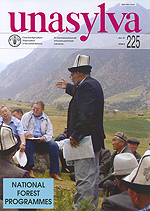J. Heino
Jan Heino is Assistant Director-General, Forestry Department, FAO, Rome
How FAO supports national forest programmes – tools enabling any country
to create a national vision and long-term strategy for its forest sector.
National forest programmes (NFPs) have a vast potential to serve country-specific needs in the forest sector. They are much more than mere documents. Good examples show that they are vigorously functioning forest policy formulation processes.
The concept of a national forest programme can be expressed rather simply: it is a tool enabling any country to create a national vision and long-term strategy for its forest sector. In practice, however, there are many challenges in developing and implementing NFPs that provide real value. Prerequisites for a successful outcome include accurate inventory and assessment data, state-of-the-art analysis of the forest sector, participatory programme formulation within the forest sector and with all relevant interacting sectors, and processes for implementing and monitoring progress (see article by Sepp and Mansur in this issue).
NFP formulation and implementation is and should be led by governments in participatory processes. Responsibilities for implementation and follow-up should be incorporated into the work of a wide range of players within the forest sector, and also delegated to adjacent sectors and relevant stakeholders. The governmental lead role underscores the need for political commitment.
NFPs have been successfully used above all as frameworks for participatory policy formulation and implementation. Their success can be often explained by the fact that they combine the interests of many stakeholders. Even if unanimity might be difficult to reach, the consensus-
building effect of a participatory approach is often important for implementation.
Efforts to induce representatives from other sectors to participate usually promotes integration of forestry with other sectors, an effect that is often underestimated. Creation of NFPs may also help forestry obtain adequate recognition in other national programmes and strategies, notably those developed to reduce poverty.
One of FAO’s key tasks is to provide technical and financial support to countries, especially developing countries and those in transition, for formulating and implementing viable NFPs.
FAO views NFPs as basic tools enabling countries to formulate their own forest sector goals independently. FAO assists countries in gathering and managing forest-related information needed for policy formulation in NFPs, and makes this information available at the global level through statistical databases, forest resources assessments and forest-sector outlook studies.
The Organization’s mandate and constituency facilitate interaction with and among national authorities responsible for policy development and implementation. FAO hosts the National Forest Programme Facility, a multidonor mechanism in support of NFPs worldwide (see page 13). A recent independent mid-term evaluation of the Facility confirmed its usefulness as a mechanism for supporting countries in specific NFP implementation tasks. Collaboration between FAO and the Facility creates synergies, for example in capacity building for planning and implementing NFPs.
FAO is in a position to support capacity building in many ways to enhance NFPs. One of the Organization’s tasks is to offer broad technical expertise in subject areas that constitute important elements of NFP development and implementation; examples include participatory processes, financial mechanisms for sustainable forest management, forest law enforcement, conflict management and intersectoral approaches. FAO also helps countries ensure that their NFPs are in line with international commitments.
As a neutral facilitator, FAO helps build consensus and promotes appropriate, mutually beneficial partnerships. As the chair of the Collaborative Partnership on Forests (CPF) – a partnership of 14 forest-related international organizations, institutions and convention secretariats created to enhance cooperation and coordination on forest issues – FAO encourages partnership agreements among key institutions involved in the forest policy debate at the global level.
Finally, FAO supports implementation of a wide range of field projects related to NFPs, based on the requests of member countries. Improving forest assessment methods, forest management practices, forest law enforcement strategies, fire management and forestry education are just a few examples of field-level assistance linked to NFPs.
Thus virtually every member country has benefited directly or indirectly from FAO support to national forest programmes. Although it is difficult to measure the magnitude of the support, the Map provides some highlights.
Requests from countries for additional assistance in initiating and implementing NFPs vastly exceed the Organization’s present resource limits. The budgetary outlook within FAO’s regular programme of work foresees little possibility for expansion; hence, any strengthening of NFP support has to be based on extrabudgetary funding. In this respect I would like to recognize the long-term commitment of some donor countries for this very purpose, especially Austria, Finland, France, Germany, Ireland, Japan, the Netherlands, Norway, Sweden, the United Kingdom and the United States, as well as the European Union.
FAO is working hard to promote more integration within the Organization, with partner institutions and in member countries in support of NFPs. The aim is to contribute effectively to the development of NFPs that are genuinely built on the principles of country leadership; consistency within the forest sector and integration with other sectors; and partnerships and the participation of all actors. Countries and partners are invited to join us in efforts to further increase our assistance to countries to create high-quality NFPs.
| FAO support to NFPs: some recent examples |
 |